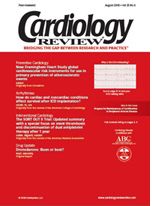Publication
Article
Cardiology Review® Online
Drug-eluting stent comparisons find similar rates of restenosis, except in diabetic patients
Drug-Eluting Stents
Orlando—The sirolimus-eluting stent (Cypher) and the paclitaxel-eluting stent (Taxus) are similarly effective in preventing restenosis in the treatment of routine coronary artery stenoses, but the sirolimus-eluting stent may offer an advantage in patients with diabetes, said investigators at the American College of Cardiology Annual Scientific Session 2005.
In an international head-to-head comparison between the two stents, lead investigator Marie Claude Morice, MD, said that the overall findings produced
little to preferentially choose one stent over the other. “They are both very durable and very efficient to prevent restenosis,” she said, adding that the re-sults of the clinical trial would not change her practice.
The REALITY study, the largest one conducted to compare the two stents, randomly assigned 1,386 patients in Europe, Latin America, and Asia to receive the sirolimus- or paclitaxel-eluting stent. To be eligible, patients had to have one or two de novo lesions in a native coronary artery. Twenty-eight percent of the study population had diabetes.
At 8 months, the rates of in-lesion restenosis or in-stent restenosis were
not significantly different between the two stents, said Dr. Morice, head of
the Institut Hospitalier Jacques Cartier, Massy, France.
Other angiographic parameters did favor the sirolimus-eluting stent, including mean lumen diameter and in-lesion and in-stent restenosis. The significant increase in late-stent thrombosis in the patients receiving the paclitaxel-eluting stent will require further investigation, she said. In addition, a greater number of acute and subacute stent thromboses occurred with the paclitaxel-eluting stent than with the sirolimus-eluting stent (1.8% versus 0.4%; P = .0196), which is the first indication of a “significant safety difference between drug-eluting stents,” said Dr. Morice.
Still, the rates of target-lesion revascularization and major adverse coronary events were similar between the patient groups, Gregg Stone, MD, professor of medicine at Columbia University in New York City, reminded the audience, and it
is these clinical outcomes that concern patients the most.
A single-center study showed that the sirolimus-eluting stent was more effective than the paclitaxel-eluting stent in preventing restenosis in the high-risk subset of diabetic patients, according to Adnan Kastrati, MD, from the Deutches Herzzentrum, Munich, Germany.
Percutaneous interventions have historically been associated with high rates of restenosis in the diabetic population, said Dr. Kastrati. His study included 250 patients with diabetes with angina or a positive stress test in the presence of 50% or more stenosis in native coronary vessels. They were randomly assigned to one of the stents and followed up at 6 months with an angiogram to measure late lumen loss, and at 9 months to compare the rate of clinical events.
In-segment late lumen loss was significantly less in the patients assigned to the sirolimus- versus the paclitaxel-eluting stent (0.43 versus 0.67 mm; P < .001), as was in-stent late lumen loss (0.19 versus 0.46 mm; P < .001). Angiographic restenosis occurred in 6.9% versus 16.5% (P = .03) of patients assigned to the sirolimus and paclitaxel stents, respectively.
At 9 months, there was no significant difference in the rates of mortality and myocardial infarction between the two groups.
